After a successful touchdown on Mars last week, the Zhurong lander has sent back both black and white and color images. Plus, pulsars, ocean depths, heavy metal vapor, radioactive elements, and this week’s What’s Up which includes a total lunar eclipse!
Media
Transcript
Hello and welcome to the Daily Space. I am your host Dr. Pamela Gay.
And I am your host Beth Johnson.
And we are here to put science in your brain.

Earlier, we reported that China has become the second nation ever to land a mission on Mars. Their rover, Zhurong, has landed in Utopia Planitia. Following the tradition of tourists everywhere, Zhurong has taken a selfie and photographed its Instagram-worthy surroundings. According to a post in Nature, the exact landing site hasn’t yet been imaged by HiRISE, but similar regions show remarkable dunes. With the constantly changing surface, there is the potential for Mars to reveal its past like so many fossils revealed in a changing desert.
We use the techniques we’ve learned on Earth to understand our world to now understand Mars. But this isn’t to say we actually understand Earth. One particularly terrifying event 1700, for instance, is now getting new attention.
On January 26, 1700, an earthquake killed the population of large swaths of Vancouver Island and the surroundings, and also sent a tsunami sweeping across the ocean all the way to Japan where it was still able to do damage. This was triggered by a slip in the Cascadia fault line. Concern that this fault line could once again trigger an earthquake around magnitude 9 influences building construction in the northwest of the United States and Canada and is part of the justification for earthquake and tsunami alert systems. These systems, however, assume all the damage was triggered by a single quake.

Now, researchers modeling the damage spoken of in oral histories of the First Nations people in that region and marked in the geological record are considering the possibility that this event wasn’t just one horrifying earthquake but may actually have been a series of strong earthquakes over several days and years. According to study author Diego Melgar: The tradition has been only ‘a mega-quake explains everything,’ and what I found is that’s not true. A megaquake still can explain everything, but so can a sequence of events.
This is decidedly not good news. While a single massive magnitude 9 or so earthquake is horrifying, a series of magnitude 8 earthquakes would continue to damage and re-damage the region, making rebuilding efforts perhaps feel futile during the decade of devastation. To understand which of these two scenarios – a megaquake or a series of massive quakes – matches reality, a detailed study of the coastal rocks is needed.
It is well understood that the coastline changed as a result of the quake or quakes with the coastline subsiding, or dropping, as the faultline shifted. If the shift occurred all at once, the record of small organisms living on the rocks will show a sudden change along the length of the coast, while a series of quakes and piecemeal subsidence would cause the organisms on the rocks to change over time.
Either way, I’m fascinated, and Pamela continues to refuse to move to Vancouver.
I do admit to being really worried about that faultline. When the Cascadia fault slipped, ocean water was sloshed into the mountains where it created saltwater marshes and killed trees. While I love the science of this, I choose to live where there are tornadoes instead of tsunami. We all have our limits.
Maybe. I mean, physics doesn’t always seem to have limits to how large or small some phenomena can be.

Pulsars, to switch topics wildly, are these tiny dead stars that can spin at all manner of speeds, and using the fairly new and truly giant FAST radio telescope in China, scientists are starting to document these extremes.
In a new paper in Astronomy & Astrophysics, researchers release the first findings of the Galactic Plane Pulsar Snapshot. With five percent of the survey complete, they have already found 201 pulsars, including some of the lowest energy pulsars so far detected, and sixteen binary systems.
While pulsars are interesting for their own qualities – they are more massive than the sun, the diameter of Manhattan, and can spin thousands of times a second – pulsars are weird enough on their own to be worth studying, but they are also useful for looking at the properties of our galaxy. As their pulses travel through space, they are dispersed by the particles scattered about. Pulsar pulses are particularly sensitive to the distribution of rogue electrons, and these early results seem to indicate that there are a lot more rogue electrons than previously understood. Over time, as this survey grows, we’ll be able to map out this distribution and understand how it affects our view of the universe beyond.
As much as we struggle to understand the depths of outer space, we are also still struggling to map our own planet. Getting to the seafloor requires us to build vessels capable of surviving extreme pressure, coldness, and making measurements in utter darkness. In some ways, designing for the vacuum of space is far easier, actually, and if a spacecraft springs a leak, it can probably be repaired with a space version of duct tape. That doesn’t work with high-pressure water.

This is where we find, working parallel to space explorers, a company of aquanauts who are trying to define what lies beneath the seas. In a new study, answering one simple question – where are the deepest points in each ocean? – proved far more difficult than thought. The Five Deeps Expedition has published new depth data in the Geoscience Data Journal and documented that while the 10,924-meter deep Mariana Trench remains the deepest point in all the oceans, other deep spots aren’t quite where we expected.
For instance, we’d thought there was a particularly deep trench off the coast of Java, and there is; it just happens that the lowest section of the trench is nearly 400 kilometers away from where we’d thought. Ingloriously named Unnamed Deep, this trench descends to 7,187 meters. In the Southern Ocean, along the trench spanning from South America toward Antarctica, there is also a newly discovered spot, named Factorian Deep, that lies at 7,432 meters down.
This is a reminder that the oceans are more vast than the land. Mount Everest reaches up to only 8,849 meters, and the deepest parts of the ocean are more than 10,000 meters down. Now, instead of asking “Why do we climb?”, we need to start asking “Why do we descend?”
Understanding the history of our world requires researchers of all disciplines to work together to try and build as true an account of the past as we can. Humans are notorious for telling the stories they want to be true. We also can sometimes lose information in the passing of stories from generation to generation. We understand the Cascadia fault in part thanks to the histories of the First Nations and the efforts of researchers to record these stories before they are lost. This is a relatively straightforward process where geology, oral history, and archeology in the Cascades and Japan all tell the same story of an earthquake and a massive tsunami.

Other stories are harder to sort and feel easier to dismiss. For instance, in the sixth century C.E., there was a sudden pattern of water miracles recorded in Italian texts, such as Dialogues on the Miracles of the Italian Fathers. While miracles aren’t where one would normally go looking for evidence of environmental change, in this case, these stories pointed to a sudden societal interest in water-related issues. Working together, historians and geologists were able to determine there was a temporary and dramatic change in rainfall that led to myriad water-related disasters of varying size.
To understand this, you have to look at things from a political perspective. If you are in a place where the people are afraid of flooding rivers and other water-related crises, you want them to believe their government can protect them. Today, this would lead to politicians discussing plans to build new levees and drainage systems. In the sixth century, it instead meant politicians discussing how powerful individuals had performed water-related miracles to save the lives of communities. Just as we can’t always trust politicians to follow through and build levees, we also can’t trust historical leaders to have always spoken of true miracles. There may have been real lives saved in some instances, but all we know for fact is that the uptick in reported miracles reflected a region in crisis as too much rain led to environmental damage.
So, scientists, it turns out we need to know history to understand our Earth, and historians, you need to know science to contextualize our history.
It’s not just the history of our own planet that we continue to try and understand; it’s the history of the solar system. And one of the ways we try to understand our solar system is by studying asteroids and comets – those smaller bodies that formed in the very young solar system, about 4.6 billion years ago. In a new study published in Nature, scientists have taken a look at the atmospheres of about twenty comets to try and understand these icy bodies.

Yes. Comets have atmospheres. In fact, a separate team studying interstellar comet 2I/Borisov found nickel vapor in its atmosphere. And this team found both iron and nickel vapor in the atmospheres of their twenty comets. These results were surprising all around because, while the metals are expected in the interiors of the comets, they weren’t expected in the atmospheres. Heavy metals don’t become gaseous at low temperatures.
Even more strange, the two metals were found in equal amounts in these atmospheres when normally, there is ten times more iron than nickel. So why were there iron and nickel vapor in the atmospheres of comets some 480 million kilometers away from the Sun? That’s the new question being asked. Co-author Emmanuel Jehin noted: Comets formed around 4.6 billion years ago, in the very young Solar System, and haven’t changed since that time. In that sense, they’re like fossils for astronomers.
These results mean we still don’t completely understand our early solar system, but co-author Damien Hutsemékers explains: We came to the conclusion [iron and nickel] might come from a special kind of material on the surface of the comet nucleus, sublimating at a rather low temperature and releasing iron and nickel in about the same proportions.
More work still needs to be done, and we’ll update you as we learn more.
If you want to get even heavier elements like gold, uranium, and plutonium, you need a really violent event to happen — like two neutron stars merging. Or so we thought. Now, though, a new study published in Science examines the possibility that it merely takes a supernova to produce such elements. Maybe.

The story starts with the discovery of an extraterrestrial isotope here on Earth in the ocean crust: plutonium-244. This isotope was found alongside another radioactive one: iron-60. Both of these isotopes are evidence of something violent happening close-ish to our solar system millions of years ago, and then the interstellar gas and dust that contained all these radioactive elements lingered and found their way to Earth. We know they weren’t a part of the material that formed our solar system because these elements would have completely decayed in the past four billion years.
So why do these scientists think that a simple supernova, if a supernova could ever be thought of as simple, created the plutonium-244? Because it was found alongside that iron isotope. We know that iron-60 is formed in supernovae, and for the plutonium to be co-existing in the crust, they may have formed together. In a supernova. That happened near Earth. Yikes.
Lead author Anton Wallner notes, however: Our data could be the first evidence that supernovae do indeed produce plutonium-244. Or perhaps it was already in the interstellar medium before the supernova went off, and it was pushed across the solar system together with the supernova ejecta.
It’s an interesting line of research, and I’m curious to see where it goes. Either way, it continues to come back to the fact that, as Carl Sagan said: We are all made of star stuff.
What’s Up
When we look at the night sky, we are seeing the history of all that has been and the conditions that will define all that will be. You just need to know where to look.
One of my favorite pieces of science learned as a child is that an asteroid killed the dinosaurs while spreading a layer of iridium over the planet and creating weird features called cenotes in the Yucatan peninsula that allowed civilizations to thrive geologic epochs later.

On any given night, you can go out and easily photograph asteroids moving across the sky if you just have a way to track your camera or a telescope with a camera. Tracking means your camera changes its position to move with the stars across the sky. Since asteroids move faster, you can see them as jumping dots, moving between images in a series.
The best place to look for these wandering stars is along that band across the sky called the ecliptic. This band is both where the Sun can be seen and where the planets move in their orbit, and it represents the disk of our pretty flat solar system. This line is making itself easy to find right now. Looking west at dusk, you can see the line of Venus, Mercury, and Mars with the Moon rising fairly high in the sky.
As the night progresses, the worlds will sink, and to the east, Saturn and Jupiter will rise late, rising up to define the eastern path of this band. Software like SkySafari can help you identify these worlds. It uses your phone’s sensors to tell you what is in the sky behind your device as you look around. Go out, look up, look at our solar system, and know that you now know roughly what part of the sky hides a dinosaur-killing rock.
All of that geometry leads to a pair of special events that occur during what we call eclipse season. “Season” is a bit of a misnomer. It’s not a season like spring or summer; it’s a period of time when we get a pair of eclipses: one lunar and one solar eclipse. Now, these eclipses aren’t always or even usually total eclipses; they don’t block out the Moon or Sun completely every time. And every pair of events is different. But this pair happens to have a total lunar eclipse, which makes it exciting.

This total lunar eclipse will happen on May 26, and it will be a short one. Totality, that period when the Moon is completely covered by the Earth’s shadow, will last just over fourteen minutes. We get a bit of a bonus here because it’s also the closest full moon of 2021, making it a supermoon. According to EarthSky: This total lunar eclipse is visible from western North America, southern and far-western South America, the Pacific Ocean, New Zealand, Australia, and Southeast Asia.
From the Americas, you’ll want to be up early in the morning, before sunrise. From the Eastern Hemisphere, you’ll want to go out at sunset. The Moon will either be setting or rising, respectively, and then you can watch it move into and out of Earth’s shadow, turning red during totality. Unlike a solar eclipse, you don’t need any special gear to watch a lunar eclipse, so get out and take some pictures. We’ll have all the exact times and charts on our website at DailySpace.org.
But what about if you’re not in a region that will see the total eclipse? Well, the good news is that if you’re in the rest of the Americas or the eastern half of Asia, you’ll get a partial umbral eclipse where Earth’s shadow will take a bite out of the Moon. Sorry, Africa and Europe. The geometry doesn’t work out for you this time. You will, however, get the opportunity to view next month’s annular solar eclipse on June 10. We’ll talk more about that event when we get closer.
For now, though, this has been the Daily Space.
Learn More
China Rover Sends Back Surface Images
- Zhurong rover rolls onto Martian surface a week after landing (SpaceNews)
- Why the China Mars rover’s landing site has geologists excited (Nature)
Historic Quake Helps Explain Tomorrow’s Tsunami
- Was a humongous Cascadia earthquake just one of many? (Live Science)
- “The 26 January 1700 Cascadia Earthquake as Part of an Event Sequence,” Diego Melgar, 2021 April 20, 2021 Annual Meeting (abstract)
First Pulsar Survey Data Released From FAST
- CAS press release
- “The FAST Galactic Plane Pulsar Snapshot survey: I. Project design and pulsar discoveries,” J. L. Han et al., 2021 May, Research in Astronomy and Astrophysics
Deepest Places on Earth Now Defined
- Oceans’ extreme depths measured in precise detail (BBC)
- “High-resolution multibeam sonar bathymetry of the deepest place in each ocean,” Cassandra Bongiovanni, Heather A. Stewart, and Alan J. Jamieson, 2021 May 5, Geoscience Data Journal
Finding Climate Data in Story and Myth
- Holy Water: Miracle Accounts and Proxy Data Tell a Climate Story (Eos)
- “Beyond one-way determinism: San Frediano’s miracle and climate change in Central and Northern Italy in late antiquity,” Giovanni Zanchetta et al., 2021 March 20, Climatic Change
Heavy Metal Vapors Found at Comets
- ESO press release
- “Iron and nickel atoms in cometary atmospheres even far from the Sun,” J. Manfroid, D. Hutsemékers, and E. Jehin, 2021 May 19, Nature
- “Gaseous atomic nickel in the coma of interstellar comet 2I/Borisov,” Piotr Guzik and Michał Drahus, 2021 May 19, Nature
Supernovae Leave Traces in Ocean Crust
- ANU press release
- “60Fe and 244Pu deposited on Earth constrain the r-process yields of recent nearby supernovae,” A. Wallner et al., 2021 May 14, Science
What’s Up: The Ecliptic and a Total Lunar Eclipse
- May-June 2021: A Special Pair Of Eclipses (EarthSky)
- Why Not An Eclipse At Every Full And New Moon? (EarthSky)
- Dawn Delight: Catch the Total Lunar Eclipse on May 26th (Sky & Telescope)
Credits
Written by Pamela Gay and Beth Johnson
Hosted by Pamela Gay and Beth Johnson
Audio and Video Editing by Ally Pelphrey
Content Editing by Beth Johnson
Intro and Outro music by Kevin MacLeod, https://incompetech.com/music/

 We record most shows live, on Twitch. Follow us today to get alerts when we go live.
We record most shows live, on Twitch. Follow us today to get alerts when we go live.